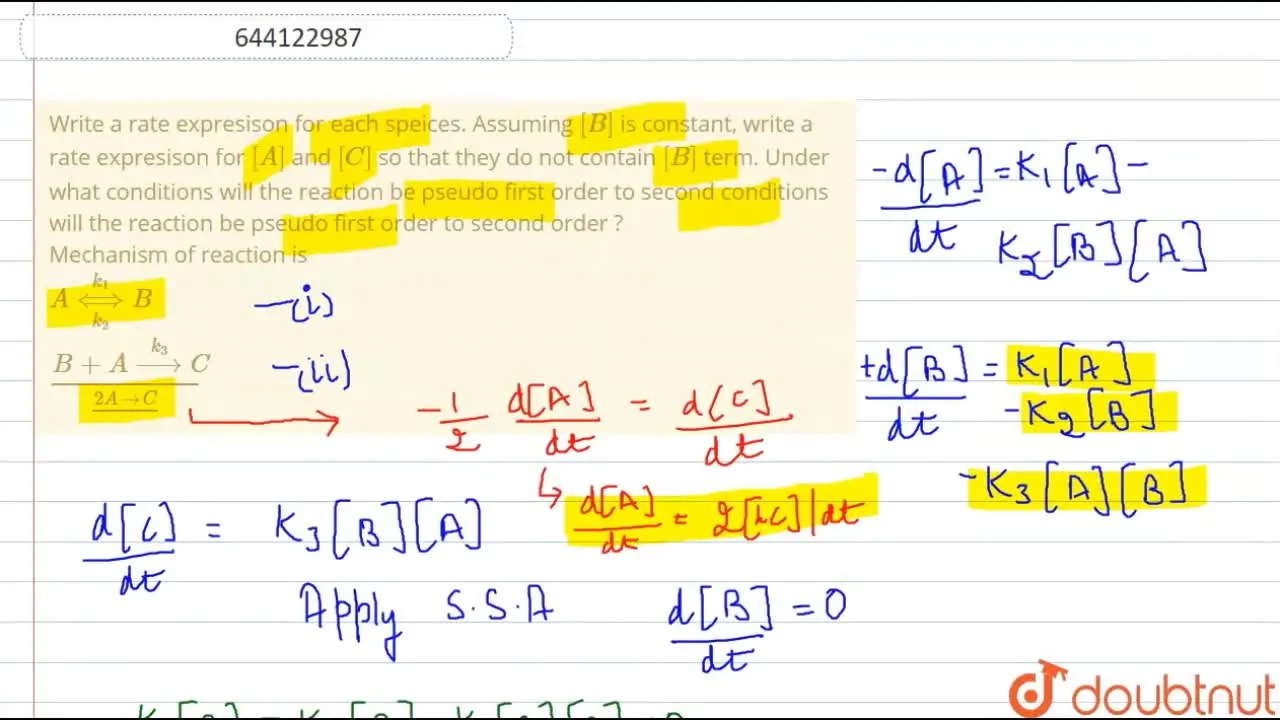Write a rate expresison for each speices. Assuming [B] is constant, write a rate expresison for [A] and [C] so that they do not contain [B] term. Under what conditions will the reaction be pseudo first order to second conditions will the reaction be pseudo first order to second order ?
Mechanism of reaction is
Ak1⇐⇒k2B
B+Ak3−−→C2A→C
The rate expresison are:
−d[A]dt=k1[A]−k2[B]+k3[B][A]
d[B]dt=k1[A]−k2[B]−k3[A][B]
d[C]dt=k3[A][B]
Uisng the steady state approximation for [B], i.e.,
d[B]dt=0 and solving for [B], gives
d[B]dt=k1[A]−k2[B]−k3[A][B]=0
[B]=k1[A]k2+k3[A]
Substituting this expresison for [B] into the expresison for
−d[A]dt and d[C]dt gives
−d[A]dt=k1[A]−k2k1[A]k2+k3[A]+k3k1[A]k2+k3[A][A]
=2k1k3[A]2k2+k3[A]
d[C]dt=k3[A]=k1k3[A]2k2+k3[A]
Note that −d[A]dt=2[d[C]dt]. If k3[A]>>k2, then condition for pseudo first order
d[C]dt=k1k3[A]2k3[A]=k1[A]
and if k3[A]<<k2, then condtion for pseudo secnd order
d[C]dt=k1k3[A]2k2
Related Playlists
- BOOK - CENGAGE CHEMISTRY ENGLISHCHAPTER - CHEMICAL KINETICSEXERCISE - Ex 4.1 (Objective)9videos
CHEMICAL KINETICS
- BOOK - CENGAGE CHEMISTRY ENGLISHCHAPTER - CHEMICAL KINETICSEXERCISE - Ex 4.2 (Objective)10videos
CHEMICAL KINETICS
- BOOK - CENGAGE CHEMISTRY ENGLISHCHAPTER - CHEMICAL KINETICSEXERCISE - Archives Subjective23videos
CHEMICAL KINETICS
- BOOK - CENGAGE CHEMISTRY ENGLISHCHAPTER - CARBOXYLIC ACIDS AND THEIR DERIVATIVESEXERCISE - Exercises Archives (Analytical And Descriptive)34videos
CARBOXYLIC ACIDS AND THEIR DERIVATIVES
- BOOK - CENGAGE CHEMISTRY ENGLISHCHAPTER - COORDINATION COMPOUNDSEXERCISE - Archives Subjective18videos
COORDINATION COMPOUNDS
Similar Questions
Mechanism of the reaction is:
Ak1−−→B,2Ak2−−→C+D
What is −d[A]dt ?View SolutionA reaction is first order in A and of second order in B. Write the differential rate equation for the reaction.
View SolutionA reaction is first order in A and of second order in B. Write the differential rate equation for the reaction.
View SolutionA reaction is first order in A and of second order in B. Write the differential rate equation for the reaction.
View SolutionStarting with one mole of a compound A, it is found that the reaction is 3/4 completed in 1hr. Calculate the rate constant if the reaction is of
a. First order , b. Second orderView SolutionA reaction is first order in A and second order in B : How is the rate affected when the concentrations of both A and B are doubled?
View SolutionWrite the rate equation for the reaction 2A+B→C if the order of the reaction is zero .
View SolutionDefine the following terms :
(i) Pseudo first order reactions
(ii) Half life period of reaction (t1/2).View SolutionIn a first order reaction A → B, if k is rate constant and initial concentration of the reactant A is 2 M then the half life of the reaction is:
View SolutionThe reaction A+B→C has zero order. Write rate equation.
View Solution


